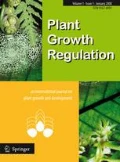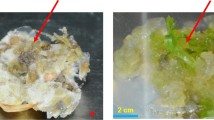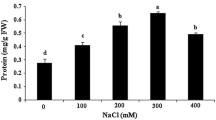Abstract
One-month old calli of two indica rice genotypes, i.e., Basmati-370 and Basmati-Kashmir were subjected to two iso-osmotic concentrations (−0.57 MPa and −0.74 MPa) created with 50 and 100 mol m−3 NaCl or 10 and 18% solutions of PEG-8000. Both genotypes tolerated only low levels of stress and showed severe growth suppression at −0.74 MPa. The degree of stress tolerance of both genotypes was greater for PEG induced stress than for NaCl induced stress. The relative growth rate of callus was reduced under both stresses, however, the reverse was true for callus dry weight. Sodium (Na+) content of the callus tissue was increased only under NaCl induced stress. Salt induced stress reduced K+ and Ca2+ contents, but the PEG induced stress increased them. Higher levels of stress increased the proline content many folds with more increase being under PEG stress than that under NaCl. Water and osmotic potentials of the callus tissue decreased, whereas turgor potential increased under both abiotic stresses. Overall, Basmati-370 was more tolerant to both NaCl and PEG induced stresses than Basmati-Kashmir, because of less reduction in growth and more dry weight. Moreover, Basmati-370 accumulated higher amounts of cations, free proline, and maintained maximum turgor as compared to Basmati-Kashmir. In conclusion, at cellular level, mechanism of NaCl induced osmotic stress tolerance was found to be associated with more ionic accumulation of inorganic solutes and that of PEG induced osmotic stress tolerance with the accumulation of free proline, as an important osmolyte in the cytosol.



Similar content being viewed by others
References
Agarwal RK, Gupta SC (1995) Plant growth substances as osmoregulants under salt stress in callus cultures of cowpea. Indian J Plant Physiol 4:325–327
Al-Khayri JM, Al-Bahrany AM (2002) Callus growth and proline accumulation in response to sorbitol and sucrose-induced osmotic stress in rice. Biol Plant 45:609–611
Al-Khayri JM (2002) Growth, proline accumulation, and ion content in sodium chloride-stressed callus of date palm. In Vitro Cell Develop. Biol Plant 38:79–82
Almansouri M, Kinet JM, Lutts S (2000) Physiological analysis of salinity resistance in Triticum turgidum var. durum Desf.: Callus versus whole plant responses. Options Mediterraneennes Ser A Seminaires Mediterraneens 40:263–265
Ashraf M, Foolad MR (2007) Roles of glycine betaine and proline in improving plant abiotic stress resistance. Env Exp Bot 59:206–216
Attree SM, Moore D, Sawhney VK, Fowke LC (1991) Enhanced maturation and desiccation tolerance of white spruce (Picea glauca (Moench) Voss) somatic embryos: effect of a non-plasmolysing water stress and abscisic acid. Ann Bot 68:519–522
Barakat MN, Abdel-Latif TH (1995) In vitro selection for drought tolerant lines in wheat. I. Effect of polyethylene glycol on the embryogenic cultures. Alexandria J Agric Res 40:97–112
Basu S, Gangopadhyay G, Mukherjee BB (2002) Salt tolerance in rice in vitro: implication of accumulation of Na+, K+ and proline. Plant Cell Tiss Organ Cult 69:55–64
Bates LS, Waldren RP, Teare ID (1973) Rapid determinations of free proline for water stress studies. Plant Soil 39:205–207
Bhaskaran S, Smith RH, Newton RJ (1985) Physiological changes in cultured sorghum cells in response to induced water stress I. Free proline. Plant Physiol 79:239–248
Binzel ML, Reuveni M (1994) Cellular mechanisms of salt tolerance in plant cells. Hort Rev 16:33–69
Camara TR, Willadino L, Torne JM, Manick A, Santos MA (2000) Effect of salt stress and exogenous proline in maize callus. Revista Brasileira de Fisiologia Vegetal 12:146–155
Chauhan VA, Prathapasenan G (2000) Growth characteristic and ion contents of rice callus under the influence of NaCl and hydroxyproline. Acta Physiol Plant 22:39–44
Cramer GR, Lauchli A, Polito VS (1985) Displacement of Ca2+ by Na+ from plasmalemma of root cells: a primary response to stress? Plant Physiol 79:207–211
Do-Quang B, Laszlo EH, Ibolya SK (2000) In vitro studies on salt tolerance in rice (Oryza sativa L.). Cahiers Options Mediterraneennes 8:25–27
Folkard A, Dingkuhn M, Wittstock C, Doerffling K (1999) Sodium and potassium uptake of rice panicles as affected by salinity and season in relation to yield and yield component. Plant Soil 207:133–145
Gangopadhyay G, Basu S (2000) Proline as osmotic stress-marker in in vitro system. In: Hemantaranjan A (ed) Plant physiology, biochemistry and plant molecular biology in 2000, vol. 3. Scientific Publishers, Jodhpur, India, pp 283–304
Gangopadhyay G, Basu S, Gupta S (1997a) In vitro selection and physiological characterization of NaCl- and mannitol-adapted callus lines in Brassica juncea. Plant Cell Tiss Organ Cult 50(3):161–169
Gangopadhyay G, Basu S, Mukherjee BB, Gupta S (1997b) Effect of salt and osmotic shocks on unadapted and adapted callus lines of tobacco. Plant Cell Tiss Organ Cult 49:45–52
Garcia A, Florido M, Perez I, Lara RM, Gonzalez MC, Marrero MT (1999) Membrane stability and total protein content in rice callus subjected to water stress. Cultivos Tropicales 20:17–20
Gonzalez S, Garcia E (1988) Effect of water stress on callus and plantlets of sugarcane. Revista del Jardin Botanico Nacional 9:57–66
Gupta SD, Auge RM, Denchev PD, Conger BV (1995) Growth, proline accumulation and water relations of NaCl-selected and non-selected callus lines of Dactylis glomerata L. Env Exp Bot 35:83–92
Handa AK, Bressan RA, Handa S, Hasegawa PM (1982) Characteristics of cultured tomato cells after prolonged exposure to medium containing polyethylene glycol. Plant Physiol 69:514–521
Hanson AD, Hitz WD (1982) Metabolic responses of mesophytes to plant water deficits. Annu Rev Plant Physiol 33:163–203
Hasegawa PM, Bressan RA, Handa S, Handa AK (1984) Cellular mechanisms of tolerance to water stress. HortScience 19:371–377
He DY, Yu SW (1995) In vitro selection of a high-proline-producing variant from rice callus and studies on its salt tolerance. Acta Phytophysiol Sinica 21(1):65–72
Hohl M, Schopfer P (1991) Water relations of growing maize coleoptiles. Plant Physiol 95:716–722
Hou JH, Geng QH, Hu RH (1992) The effect of water stress on callus of winter wheat. Acta Agric. Boreali-Sinica 7:52–56
Ikeda T, Fujime Y, Terabayashi S, Date S (2002) Water status of garlic callus under various salt and osmotic stress conditions. Hort Sci 37:404–405
Javed F (2002) In vitro salt tolerance in wheat I: growth and ion accumulation in Triticum aestivum. Int J Agric Biol 4:459–461
Juhasz GA, Sarkadi L (1994) Changes in free amino acid contents of bean callus cultures as affected by non-ionic osmotic stress. Zoldsegtermesztesi Kutato Intezet Bulletinje 26:55–61
Juhasz GA, Sarkadi SL, Velich I, Varro P (1995) The effect of non-ionic osmotic stress on bean callus cultures. Hort Sci 27:7–14
Juhasz GA, Simon-Sarkadi L, Velich I, Varro P (1997) Studies of non-ionic osmotic stress on bean (Phaseolus vulgaris L.) callus and seedlings cultures. Acta Hort 44:455–456
Lawlor DW (1970) Absorption of polyethylene glycols by plants and their effects on plant growth. New Phytol 69:501–514
Linsmaier EM, Skoog F (1965) Organic growth factor requirement of tobacco tissue cultures. Physiol Plant 8:100–127
Liu T, Staden J van (2001) Partitioning of carbohydrates in salt-sensitive and salt-tolerant soybean callus cultures under salinity stress and its subsequent relief. Plant Growth Regul 33:13–17
Lutts S, Kinet JM, Bouharmont J (1996) Effects of various salts and of mannitol on ion and proline accumulation in relation to osmotic adjustment in rice (Oryza sativa L.) callus cultures. J Plant Physiol 149:186–195
Lutts S, Kinet JM, Bouharmont J (1999) Improvement of rice callus regeneration in the presence of NaCl. Plant Cell Tiss Organ Cult 57:3–11
Muralitharan MS, Chandler SF, Steveninck RFM (1993) Physiological adaptation to high ion concentrations or water deficit by callus cultures of high bush blueberry, Vaccinium corymbosum. Aust J Plant Physiol 20:159–172
Neumann P (1997) Salinity resistance and plant growth revisited. Plant Cell Environ 20:1193–1198
Newton RJ, Sen S, Puryear JD (1987) Free proline in water-stressed pine callus. Tappi J 70:141–144
Newton RJ, Sen S, Puryear JD (1989) Solute contribution to osmotic potential loblolly pine (Pinus taeda L.) callus. J Plant Physiol 34:746–750
Newton RJ, Bhasakaran S, Puryear JD, Smith RH (1986) Physiological changes in culture sorghum cells in response to induced water stress: II. Soluble carbohydrates and organic acids. Plant Physiol 81:626–629
Nigel WB, Jotham JP, Azhakanandam K, Power JB, Lowe KC, Cocking EC, Davey MR (1999) Callus initiation, maintenance, and shoot induction in rice. In: Plant cell culture protocols. ISBN 1-59259-583-9
Orton TJ (1980) Comparison of salt tolerance between Hordeum vulgare and H. jubatum in whole plants and callus cultures. Zeitschrift fur Pflanzenphysiologie 98:105–118
Paek KY, Chandler SF, Thorpe TA (1988) Physiological effects of Na2SO4 and NaCl on callus cultures of Brassica campestris (Chinese cabbage). Physiol Plant 72:160–166
Pushpalatha T, Padmanabhan C (1998) Studies on in vitro testing for salt tolerance in callus cultures of rice (Oryza sativa L.). Current Agric 22:109–113
Pushpam R, Rangasamy SRS (2000a) Effect of salinity on protein and proline content of callus and seedlings of rice. Crop Res 20:192–196
Pushpam R, Rangasamy SRS 2000b In vitro response of rice genotypes to salt stress. Madras Agric J 87:694–697
Reddy PC, Vajranabhaiah SN (1996) The role of polyamines, ATP, kinetin and selection in stress tolerance of rice (Oryza sativa L.) calli. Adv Plant Sci 9:143–147
Rudulier DL, Strom AR, Dandekar AM, Smith LT, Valentine RC (1984) Molecular biology of osmoregulation. Science 224:1064–1068
Santos CL, Dos V, Caldeira G (1999) Comparative responses of Helianthus annuus plants and calli exposed to NaCl. I: growth rate and osmotic regulation in intact plants and calli. J Plant Physiol 155:769–777
Santos-Diaz MS, Ochoa-Alejo N (1994a) Effect of water stress on growth, osmotic potential and solute accumulation in cell cultures from chili pepper (a mesophyte) and creosote bush (a xerophyte). Plant Sci 96:21–29
Santos-Diaz MS, Ochoa-Alejo N (1994b) PEG tolerant cell clones of chili pepper: growth, osmotic potential and solute accumulation. Plant Cell Tiss Organ Cult 37:1–8
Sathish P, Gamborg OL, Nabors MW (1997) Establishment of stable NaCl-resistant rice plant lines from anther culture: distribution pattern of K+/Na+ in callus and plant cells. Theo Appl Gene 95:1203–1209
Shah SH, Wainwright SJ, Merrett MJ (1990) The interaction of sodium and calcium chlorides and light on growth, potassium nutrition, and proline accumulation in callus cultures of Medicago sativa L. New Phytol 116:37–45
Shankhdhar D, Shankhdhar SC, Mani RC (2000) In vitro selection for salt tolerance in rice. Biol Plant 43:477–480
Shibli RA, Al-Juboory K (2002) Comparative responses of “Nabali” olive microshoot, callus and suspension cell cultures to salinity and water deficit. J Plant Nut 25:61–74
Singh BR, Singh DP (1995) Agronomic and physiological responses of sorghum, maize and pearl millet to irrigation. Field Crop Res 42:57–67
Smith RH, Bhaskaran S, Newton R, Miller F (1984) Sorghum varieties screened in vitro for osmotic tolerance and physiological studies. Plant Physiol 75:174
Stavarek SJ, Rains DW (1984) The development of tolerance to mineral stress. Hort Sci 19:377–382
Stephen RG, Zeng L, Shannon MC, Roberts SR (2002) Rice is more sensitive to salinity than previously thought. Annual Report of U.S. Department of Agriculture’s Research Service, p 481
Taiz L, Zeiger E (2002) Plant physiology, 2nd edn. Sinauer Associates, Inc., Sunderland, MA
Thomas JC, Armand RL, Bohnert HJ (1992) Influence of NaCl on growth proline and phosphoenol pyruvate carboxylase level in Mesembryanthemum crystallinum suspension cultures. Plant Physiol 98:626–631
Turner NC, Jones MM (1980) Turgor maintenance by osmotic adjustment: a review and evaluation. In: Turner NC, Kramer BJ (eds) Adaptation of plants to water and high temperature stress. Willey Interscience, New York, pp 89–103
Vanekamp JH, Lampe JEM, Koot JHM (1989) Organic acids as source of drought-induced proline synthesis in field bean (Vicia faba L.) plants. J Plant Physiol 133:654–659
Willadino L, Camara T, Boget N, Claparols I, Santos M, Torne JM (1996a) Polyamine and free amino acid variations in NaCl-treated embryogenic maize callus from sensitive and resistant cultivars. J Plant Physiol 149:179–185
Willadino L, Camara T, Boget N, Claparols I, Santos M, Torne JM (1996b) Polyamine variations in sensitive embryogenic callus of maize as a response to NaCl stress. Revista Brasileira de Fisiologia Vegetal 8:161–164
Xu SC, Dai JV, Shen XY, Wang LZ, Cui Q, Zhu YL (1995) The effect of water stress on the photosynthetic characteristics and yield of maize. Acta Agronomica Sinica 21:356–363
YanJun S, GuangMin L, ChunYan X (2000) Effect of water stress on the callus of winter wheat with different drought resistance. Acta Agriculturae Boreali-Sinica 15:47–52
Yoshida S, Kasai Y, Watanabe K, Fujino M (1999) Proline stimulates albino regeneration from anther- and seed-derived rice callus under high osmosis. J Plant Physiol 155:107–109
Author information
Authors and Affiliations
Corresponding author
Rights and permissions
About this article
Cite this article
Sajid Aqeel Ahmad, M., Javed, F. & Ashraf, M. Iso-osmotic effect of NaCl and PEG on growth, cations and free proline accumulation in callus tissue of two indica rice (Oryza sativa L.) genotypes. Plant Growth Regul 53, 53–63 (2007). https://doi.org/10.1007/s10725-007-9204-0
Received:
Accepted:
Published:
Issue Date:
DOI: https://doi.org/10.1007/s10725-007-9204-0




